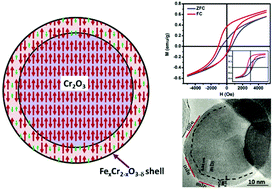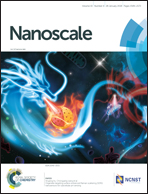Magnetic properties of core–shell nanoparticles possessing a novel Fe(ii)-chromia phase: an experimental and theoretical approach†
Abstract
Room-temperature ferrimagnetic and superparamagnetic properties, and the magnetic interactions between the core and shell, of our iron-incorporated chromia-based core shell nanoparticles (CSNs) have been investigated using a combination of experimental measurement and density functional theory (DFT) based calculations. We have synthesized CSNs having an epitaxial shell and well-ordered interface properties by utilizing our hydrothermal nanophase epitaxy (HNE) technique. The ferrimagnetic and superparamagnetic properties of the CSNs are manifested beyond room temperature and magnetic measurements reveal that the exchange bias interaction between the antiferromagnetic (AFM) core and ferrimagnetic (FiM) shell persists close to ambient temperature. The DFT calculations confirm the FiM ordering of the Fe-chromia shell. Our calculations show that the FiM ordering is associated with a band gap reduction, Fe–O d–p orbital hybridization, and AFM type Fe–Cr σ type superexchange interaction in the α-Fe0.40Cr1.60O2.92 shell of the CSNs. The novel magnetic core–shell nanoparticles possess a shell comprised of a metastable Fe(II)-chromia phase, resulting in unique magnetic properties that make them ideal for magnetic device and medicinal applications.



 Please wait while we load your content...
Please wait while we load your content...